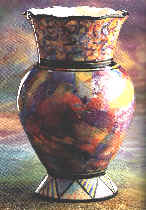|
|
Definition
This word "Ceramic" was derived from Greek word "Keramikos", which is derived from "Keramon" or "Keramos", meaning "Argil".
In the past, this word "Ceramic" was applied to dishes, made of clay, and to be cooked afterwards; but nowadays, this word comprises all products made of fictile clay and bat, such as brick, tile, clay pipe and all fire-proofs made of bat, vitreous china and various species of porcelain, as well as china-ware.
In 1822, for the first time, fireproof Cilice was made. These fire-proofs had no "clay", but were prepared with ceramic methods (First mixture was dampened, then was formed and dried and cooked.).
The word "Ceramic" held its real meaning, but also applied to clay-made objects; in the meantime, was served for all materials produced by this method. This expression was expanded in the course of time and consisted all non-clay materials used in electricity, nuclear energy and engineering, having utility in high temperature.
In United States, as declared by Ceramic Research Institute, in 1920, the word "Ceramic" used for all Cilice factories, such as glass factories, enameled metal and cement.
According to the last definition, given by the Institute "Pre ASTM, 63, 309, 1963", "Ceramic" is a general meaning, expanded to Art and Technique of preparation of objects with ceramic method or the objects made by this method.

|
|

